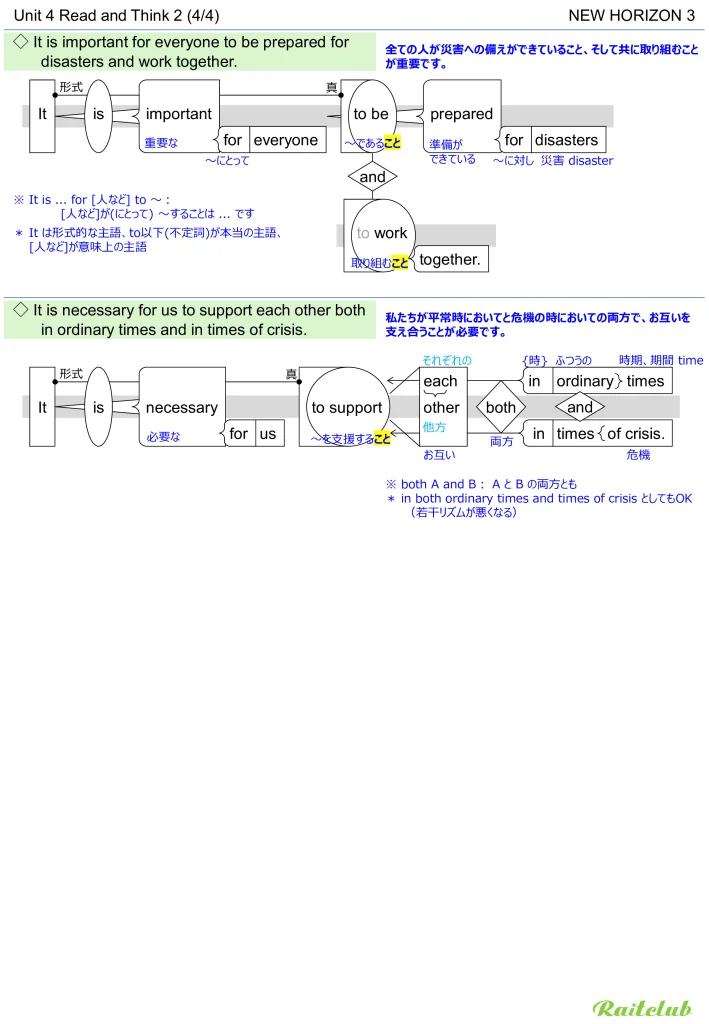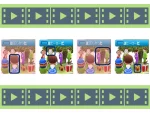中学3年生教科書 New Horizon 3 (ニューホライズン 3年) 2025~28年度用 Unit 4: How can we help each other in a disaster? の重要文法と、本文・和訳・英文見える化チャートです。
英文見える化チャートは、英語の「意味理解」を視覚的にサポートするツールです。習得を促進する音声付きです。音読活動などで活用することで英語を身に着けるのを支援します。
ポイント解説付きなので、定期テスト対策として、単語の意味・用法や、文法・文構造の確認にも使えます。
なおこのページでは英語のみの音声も聞けます。リスニングやシャドウイングなどでお使いいただけます。
重要文法
間接疑問文
➡ I know where the shelter is.
➡ Tell me what you have done.
過去分詞 < (名詞) + 過去分詞 + 語句 >
「~される/された(名詞)」
➡ Anti-Hero is a song written by Taylor.
現在分詞 < (名詞) + 現在分詞 + 語句 >
「~している(名詞)」
➡ The woman smiling there is Taylor.
本文・和訳・チャート
音声リスト
※ バックグラウンド再生もできます
以下の各パート内の音声は速度調整や個別にループ再生もできます
Unit 4 Part 1
◇ Are you prepared for a disaster?
あなたは災害への備えができていますか。
※ prepared: {何かをする、状況に対応する} 準備ができている prepared for the worst(最悪への備えあり)
≒ ready: ほぼ置き換え可(心構え・意思、即応に焦点の場合が多い) ready for the next step(次ステップへ進む用意あり)
*disaster が対象ならほぼ prepared のみ(コーパス調査)
※ a ~: {実物は特定せず一般的な1つの~に言及して} (1つの)~
*for disasters もOK(災害全般、各種災害の印象)
◇ What do you know?
あなたは何を知っていますか。
◇ Please circle the number(s).
どうか、番号(複数可)を丸で囲んでください。
※ circle: ☐ 円 draw a circle(円を描く); ☐ 人の集まり have a wide circle of friends(友だちの輪(付き合い)が広い)/ ☒ ~を丸で囲む
※ the ~: {特定の~に言及して} (訳さない)~
*ここでは各自が当てはまる番号
※ (s): 括弧付きの複数形→ 単数・複数どちらもありうる時
◆ 1. I know where the local shelter is.
1.私は地域の避難所がどこかを知っています。
◆ 間接疑問文 疑問文Aの内容を含む(別の)文
<I know など + Aの疑問詞など + Aの主語 + Aの動詞>
「Aの内容を ~する(知っている など)」
*注意ポイント: Aの主語+動詞の倒置は、しない
⇔ 普通の疑問文 Where is the local shelter?
*文全体が否定・疑問文の場合も同様(Aの倒置なし)
Do you know where the local shelter is?
参考)間接話法(発言を引用符なしで内容を伝達)での疑問文も同じ語順
◆ 2. I know how much food and water I should store.
2.私はどのくらいの食料と水を備蓄するべきかを知っています。
≒ I know how much food and water to store.(備蓄する量を知っている) *義務感はうすまる
※ store: ☐ 店/ ☒ ~を蓄える
◆ 3. I know what number I should call in case of a fire.
3.私は火事の場合に何番に電話するべきかを知っています。
≒ I know what number to call in case of a fire.(電話する番号を知っている) *義務感はうすまる
※ case: 場合; 事例
※ in case of ~: ~の場合に(…する)
※ fire: ☐ {不可算} (概念としての)火 set fire to ~(~に火をつける); ☒ {可算} 火事、たき火など形のある火 start a fire(火事を出す、火をおこす) put out a fire(火を消す)
◇ 4. I know how to use a fire extinguisher.
4.私は消火器の使い方を知っています。
≒ I know how I can use a fire extinguisher.
(どう使えるかを知っている) *可能性の意味が入る
*「~のやり方」なら how to ~ が自然で非常によく使われる
※ how to ~ など < howなどの疑問詞 + to + 動詞の原形>
どのように~するか、すべきか * 名詞として働く
※ what to ~: 何を~するか、すべきか
when to ~: いつ~するか、すべきか
※ extinguish: {火など} ~を消す extinguish a fire
*put out よりフォーマル
音声(英語/習得用)
| ♪ 英語の音声: | |
| 1回再生 | |
|---|---|
| ループ再生 | |
| ♪ 習得用の音声(英⇒日を区切りごと): | |
| 1回再生 | |
|---|---|
| ループ再生 | |
英文見える化チャート 1/2

英文見える化チャート 2/2
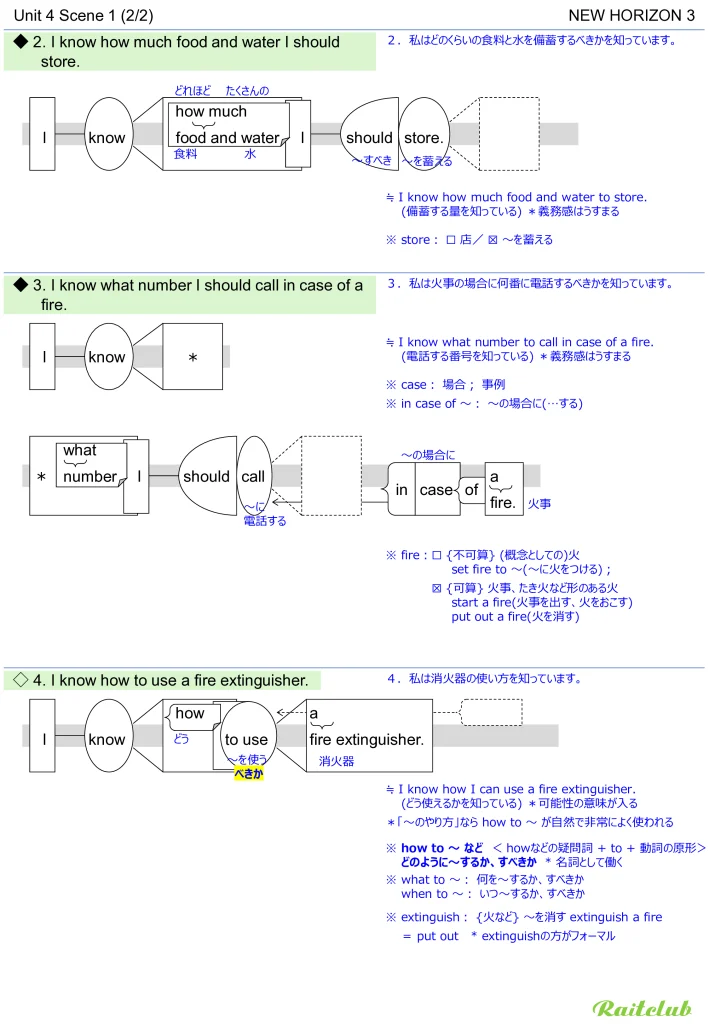
Unit 4 Part 2
◆ Riko, tell me what your family has done to prepare for a disaster.
りこ、災害に備えるためにあなたの家族が何をしてきたか教えてください。
◆ 間接疑問文 疑問文Aの内容を含む(別の)文
*Part 1では < I know + (Aの内容)> の例
*ここでは tell など目的語を2つとる動詞の例
<tell など + (人) + (Aの疑問詞 + Aの主語 + Aの動詞)>
「Aの内容を (人)に話す など」
*注意ポイント: Aの主語+動詞の倒置は、しない
⇔ 普通の疑問文 What has your family done?
*文全体が否定・疑問文の場合も同様(Aの倒置なし)
Can you tell me what your family has done?
◇ We’ve made an emergency kit.
私たちは非常用品セットを作ってあります。
◇ That’s great.
それはすばらしい。
◇ Actually, my family hasn’t made one yet.
実は、私の家族はまだそういうものを作ってありません。
※ actually: {(驚くべき)事実を強調して} 実のところ、実際は
※ one: {既に言及された名詞の代りに使い} (1つの)もの
* 実物を特定しない
参考)it: それ * 実物を特定する
◇ It’s hard for us to understand the Japanese information about disasters.
私たちが災害に関する日本語の情報を理解するのは難しいです。
※ It is … for [人など] to ~
< It is + 形容詞など + for + 人など + to + 動詞の原形>
[人など]が(にとって) ~することは … です
*It は形式的な主語、to以下(不定詞)が本当の主語、[人など]が意味上の主語
※ = To understand the Japanese information about disasters is hard for us.
※ the Japanese information … と the で(Part 1で見た自治体のものなど)特定の情報全般に言及 (ないと災害情報一般への言及→この文脈ではほぼ同じ意味に)
◇ I can send you a link.
私はあなたにリンクを送ることができます。
※ link: ☐ ~をつなぐ link the two ideas(その2つのアイデアをつなげる)/ ☐ つながり・相互関係 the link between smoking and cancer(喫煙とがんの関連性); ☒ (ネットでの)リンク
◆ It shows you what you should prepare in English.
それはあなたに何を準備すべきかを英語で示します。
◇ Oh, thanks!
ああ、ありがとう!
◇ You’re welcome.
どういたしまして。
※ you’re welcome: お礼の言葉への丁寧な回答
◇ By the way, my dad recommended a movie about an earthquake.
ところで、私のパパが地震に関するある映画をすすめました。
※ by the way: {新しい話題を導入する時} ところで
◇ Why don’t we watch it together?
一緒にそれを見ませんか。
※ Why don’t we ~: ~しませんかと相手をさそう表現
*否定疑問文で「なぜ私たちは~しないのですか(しますよね)」とたずねている
◇ Sure.
もちろんです。
音声(英語/習得用)
| ♪ 英語の音声: | |
| 1回再生 | |
|---|---|
| ループ再生 | |
| ♪ 習得用の音声(英⇒日を区切りごと): | |
| 1回再生 | |
|---|---|
| ループ再生 | |
英文見える化チャート 1/2
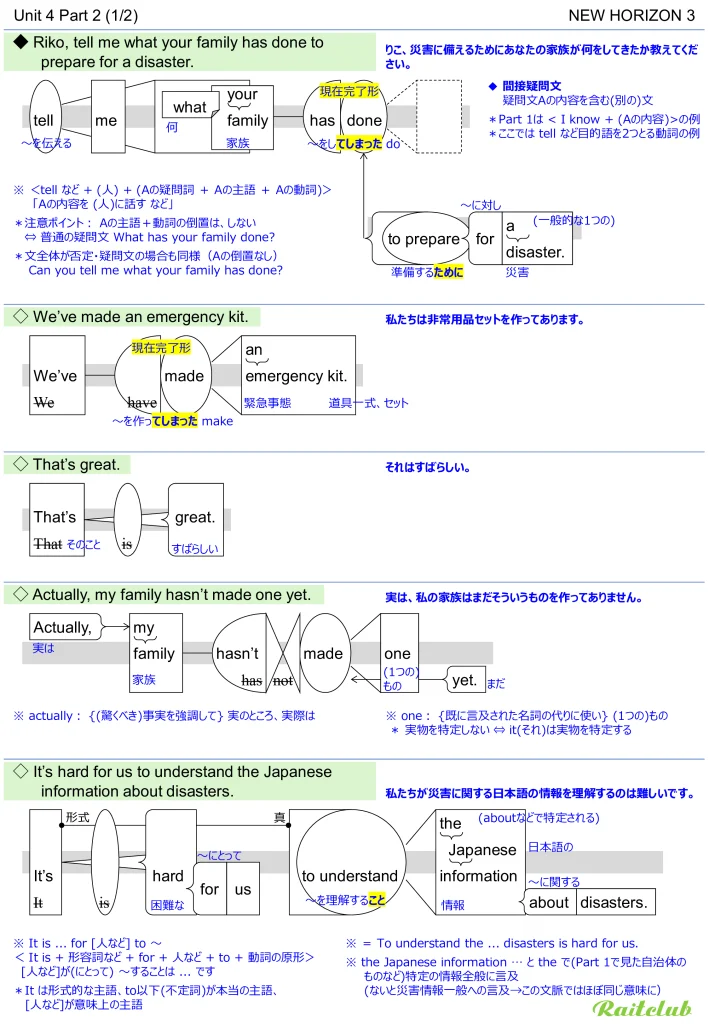
英文見える化チャート 2/2
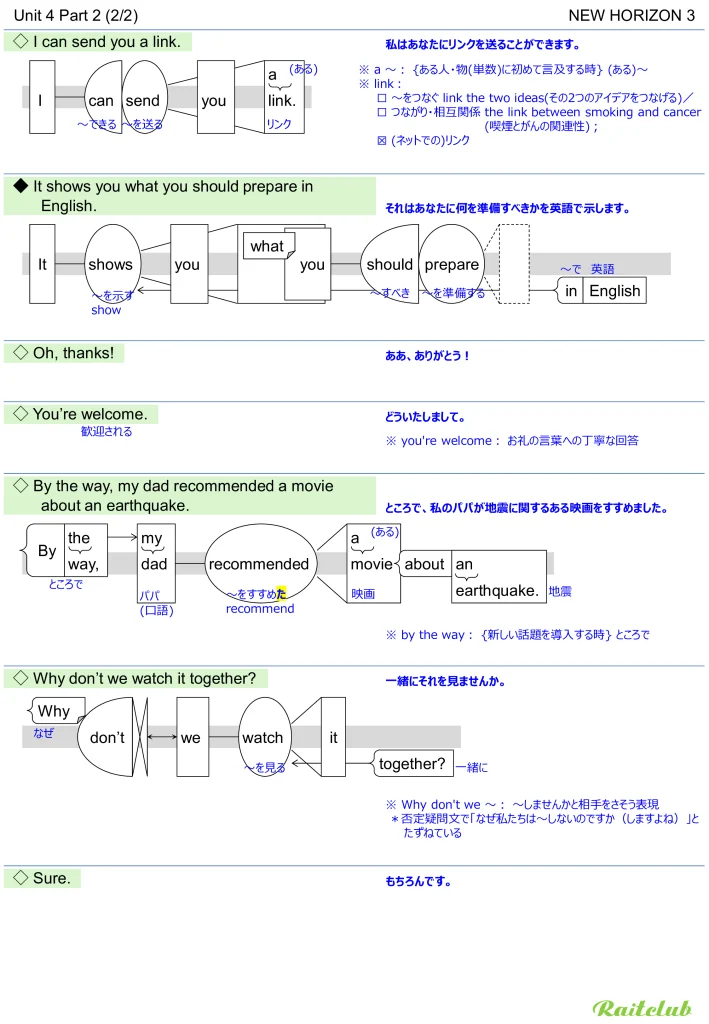
Unit 4 Read and Think 1
◇ About 20,000 people lost their lives in the Great East Japan Earthquake on March 11, 2011.
約2万の人々が2011年3月11日に東日本大震災で命を失いました。
◇ Several foreigners were also killed in the disaster.
何人かの外国人もまたその災害で亡くなりました。
※ several: いくつかの
* a few(少し(2, 3など))より多いが many(たくさん)ではない
◆ There is a movie called Live Your Dream: The Taylor Anderson Story.
「夢を生きる テイラー・アンダーソン物語」と呼ばれる映画があります。
◆ 過去分詞
*動詞から派生し「~される/された」の意味の形容詞として働く
< (名詞) + 過去分詞 + 語句 > 「~される (名詞)」
※ live: ☐ 住む・生きる live in Tokyo, live in the 18th century; ☒ {生き方のタイプ} ~を生きる live a quiet life(静かな人生を生きる)
*タイトルの直訳は「あなたの夢を生きなさい」
◆ The woman smiling in a kimono in the picture is Taylor.
写真の中で着物を着て微笑んでいる女性がテイラーです。
◆ 現在分詞
*動詞から派生し「~している」の意味の形容詞として働く
< (名詞) + 現在分詞 + 語句 > 「~している (名詞)」
※ The woman in the picture, smiling in a kimono, is Taylor.(写真に写っている、着物で微笑んでいる女性がテイラー)の解釈も可
◇ Taylor started to learn Japanese as a small girl in America and became attracted to Japan.
テイラーはアメリカで幼い少女のときに日本語を学び始め、日本に引きつけられるようになりました。
※ as [ ]: ☐ [役割・目的] として; ☒ [人(年齢層)] のときに
※ small: ☐ {サイズ} 小さい; ☐ {重要度} 小さい a small problem(小さな問題); ☒ {子供の年齢} 幼い・未熟な ≒ little(特に口語で) ≒ very young
※ attract: ~を引きつける Flowers attract bees.(花はハチを引きつける) ≒ Bees are attracted to flowers.(ハチは花に引きつけられる)
◇ She wanted to become a bridge between Japan and America.
彼女は日本とアメリカ相互間の橋になりたかったのです。
※ between [ ]: ☒ [接続・関係などの対象] の間の、相互間の; ☐ [場所/人/物] の間の sit between A and B
◇ In 2008, she came to Ishinomaki to work as an ALT.
2008年に、彼女はALTとして働くために石巻へ来ました。
※ as [ ]: ☒ [役割・目的] として
◇ She was an energetic and kind teacher and encouraged her students all the time.
彼女は活動的で親切な先生で、そしていつも彼女の生徒を励ましていました。
※ all the time: 常に、とても頻繁に
◇ Many students became interested in English and foreign cultures thanks to her bright personality.
多くの生徒が、彼女の明るい性格のおかげで、英語と外国文化に興味を持つようになりました。
※ thanks to ~: ~のおかげで
≒ because of ~ {汎用的}
◇ Taylor loved her students and all her new experiences in Japan.
テイラーは彼女の生徒と、日本での全ての新しい体験が大好きでした。
※ all: 全ての(形容詞(限定詞))
*the, my などと併用する時は語順に決まりあり
< all (= all of), many of, some of などの数の限定詞
→ theなど/ thisなど/ myなどの限定詞
→ newなど普通の形容詞(複数可) >
◇ Then, the earthquake hit.
そして、その地震が襲いました。
※ hit: ☐ {接触} ~を打つ、に衝突する The car hit a tree(木に衝突した); ☐ {悪影響} ~を襲う The storm hit the village(嵐が村を襲った) ; ☒ {悪影響} 襲う/ ☐ {成功} ヒット作
◇ Taylor was at school with her students.
テイラーは彼女の生徒たちと一緒に学校にいました。
◇ Taylor comforted the students and took them to a nearby safe place.
テイラーは生徒たちの不安を和らげ、彼らを近くの安全な場所へ連れて行きました。
音声(英語/習得用)
| ♪ 英語の音声: | |
| 1回再生 | |
|---|---|
| ループ再生 | |
| ♪ 習得用の音声(英⇒日を区切りごと): | |
| 1回再生 | |
|---|---|
| ループ再生 | |
英文見える化チャート 1/4
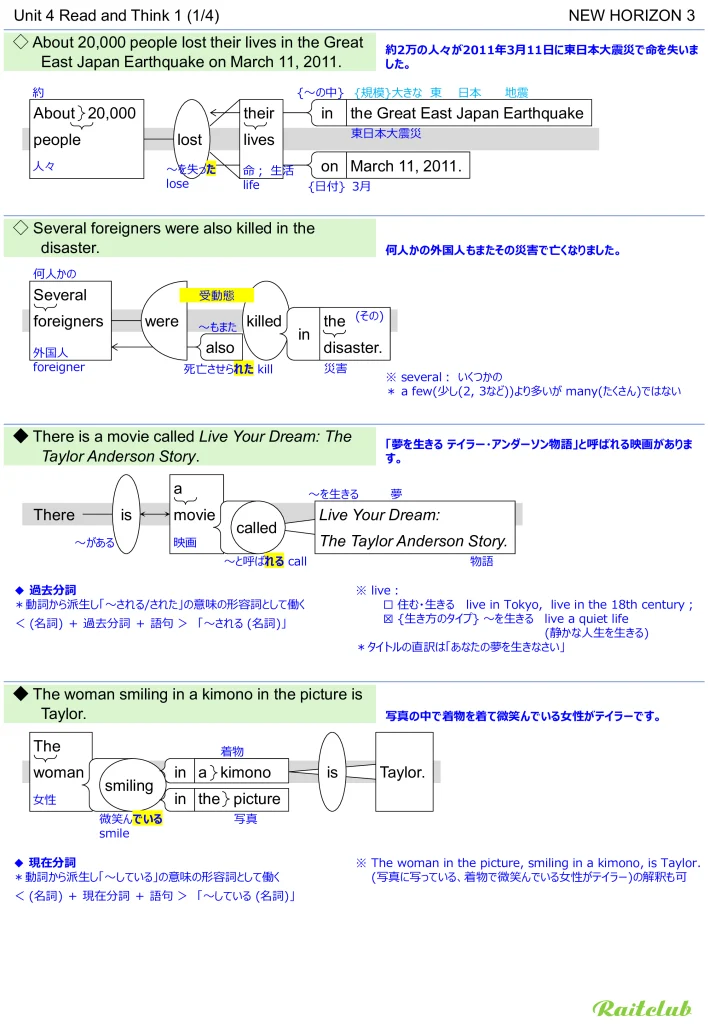
英文見える化チャート 2/4
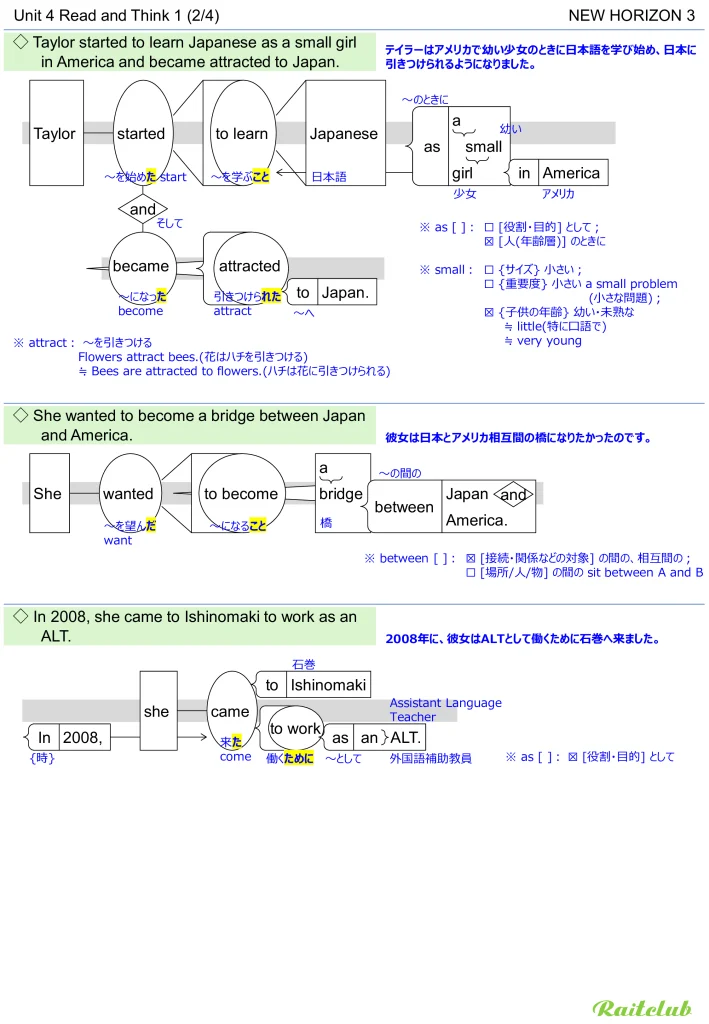
英文見える化チャート 3/4
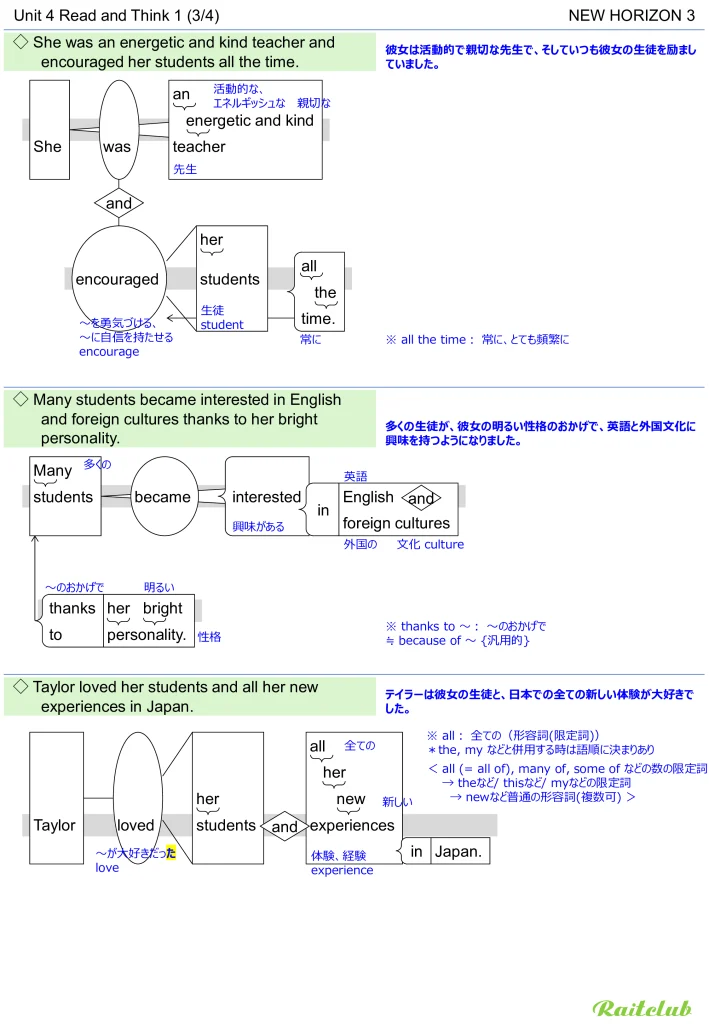
英文見える化チャート 4/4
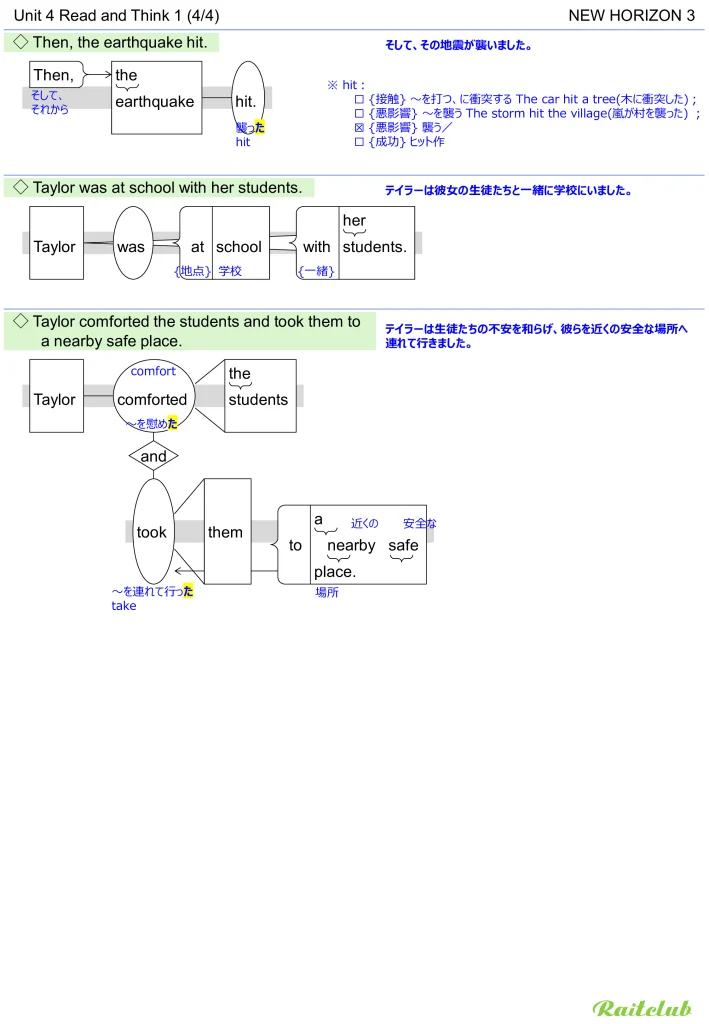
Unit 4 Read and Think 2
◇ After that, Taylor rode her bicycle toward her apartment and was caught in the tsunami on her way.
その後、テイラーは彼女のアパートに向かって自転車に乗り、その道中で津波に巻き込まれました。
※ toward: ☒ {動きの方向} ~に向かって go/come/walk toward the river(川に向かって行く/来る/歩く:到達するかは不明)
*到達をいうなら go/come/walk to the river(川へ行く/来る/歩く)
*目的地を表す表現では for を使う a train for Izu(伊豆行き電車), leave for Izu(伊豆へ出発する)
※ be caught in ~: {捕らえられた状況} ~に巻き込まれる
※ way: ☒ 道、経路 the way to the station(駅への道); ☐ 方法 in various ways(さまざまな方法で); ☐ 様式、態度 in my own way(私自身のやり方で)
◇ She died at the age of twenty-four.
彼女は24歳で亡くなりました。
※ of [ ]: ☒ [数量] の a history of over 400 years(400年超の歴史) ☆ 追加説明 ~の
◇ Taylor’s family was shocked at the sudden news.
テイラーの家族は突然の知らせにショックを受けました。
※ at [ ]: [感情などの原因の物など] を見て・聞いて ☆ 一点
※ shocked: {想定外の不快なことに} 衝撃を受けて
*shocked by (~によって)もよく使われる(surprised と同様)
◇ Shortly after the earthquake, Taylor’s parents and their friends worked together to create “Taylor Reading Corner” in Ishinomaki schools.
その地震のすぐ後、テイラーの両親と彼らの友だちは石巻の学校に「テイラー文庫」を新設するために共に取り組みました。
※ shortly: すぐに (soon よりフォーマル)
= soon after the earthquake
※ work: ☐ {お金のため} 働く work for a law firm(法律事務所で働く); ☒ 達成しようと努力する; ☐ {機械や手法} 動く、効果がでる my plan worked well(計画がうまくいった)
◇ They also started student exchange programs.
彼らは学生交換プログラムを始めもしました。
◇ That was because Taylor loved reading books for herself and to her students, and she always wanted to bring people together.
それというのも、テイラーは彼女自身のためや彼女の生徒たちへ読み聞かせて本を読むことが大好きで、いつも人々をひとつにすることを望んでいたからです。
※ that is because [節]: それは [節] だからだ
* because が以下の 接続詞 that(~ということ)に似た働きをしている
≒ the reason is that [節]: その理由は [節] だ
(≒ the reason is because [節] も冗長だが使われる)
*Merriam-Webster「’The Reason Is Because’: Redundant But Acceptable」参照
※ |bring together| ~: ☒ ~(人など)をまとめる、団結させる; ☒ ~を互いに親しくさせる
= bring ~ together → ~が代名詞の場合はこの形のみ
◇ Many of Taylor’s students kept on studying English, and some became English teachers.
テイラーの生徒の多くは英語を勉強し続け、何人かは英語の教師になりました。
※ many: ☒多くの人・物/ ☐多くの many students(多くの生徒)
※ |keep on| …ing: … し続ける
◇ Taylor is no longer with us today, but her dream lives on in the hearts of many people.
テイラーは現在ではもう私たちと一緒ではありません、しかし彼女の夢は多くの人々の心の中で生き続けます。
※ no longer: もはや~ない
=Taylor is not with us any longer (no longer の方がフォーマル)
※ |live on|: 生き続ける
◇ Every year, many foreign people come to live in Japan.
毎年、多くの外国の人々が日本に住むためにやってきます。
◇ It is important for everyone to be prepared for disasters and work together.
全ての人が災害への備えができていること、そして共に取り組むことが重要です。
※ It is … for [人など] to ~: [人など]が(にとって) ~することは … です
* It は形式的な主語、to以下(不定詞)が本当の主語、[人など]が意味上の主語
◇ It is necessary for us to support each other both in ordinary times and in times of crisis.
私たちが平常時においてと危機の時においての両方で、お互いを支え合うことが必要です。
※ both A and B: A と B の両方とも
*in both ordinary times and times of crisis としてもOK(若干リズムが悪くなる)
音声(英語/習得用)
| ♪ 英語の音声: | |
| 1回再生 | |
|---|---|
| ループ再生 | |
| ♪ 習得用の音声(英⇒日を区切りごと): | |
| 1回再生 | |
|---|---|
| ループ再生 | |
英文見える化チャート 1/4
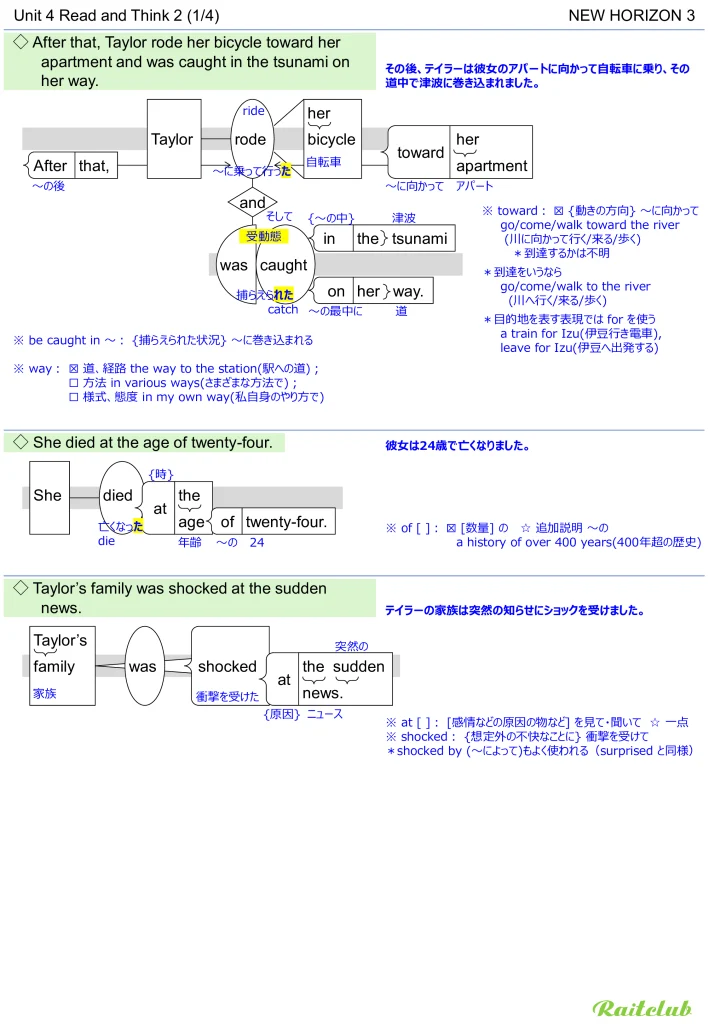
英文見える化チャート 2/4
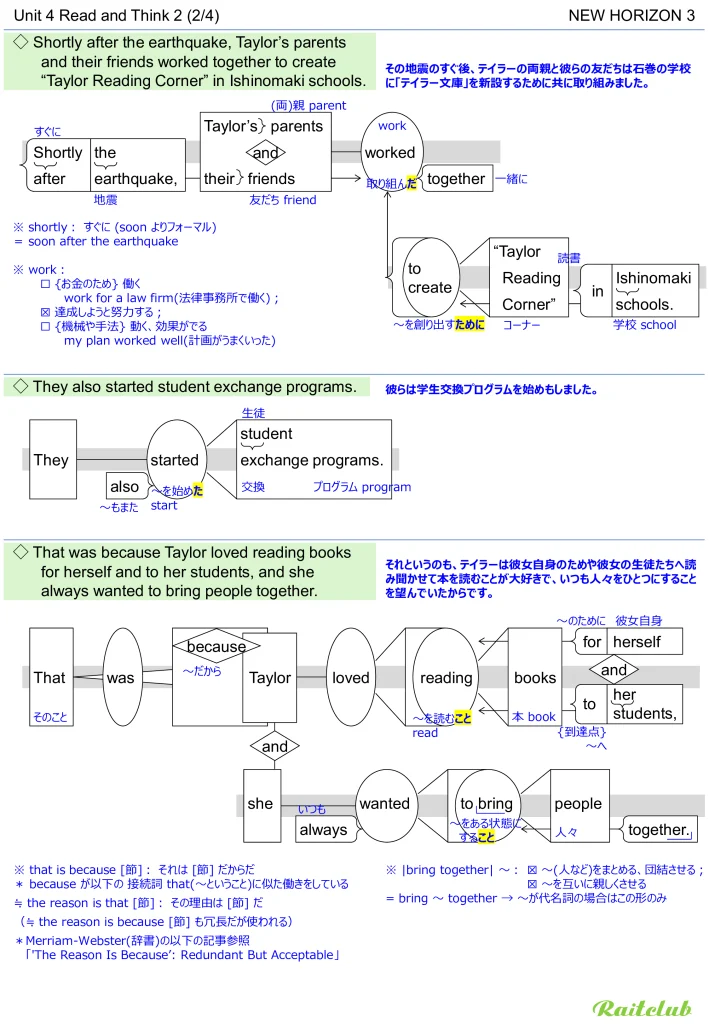
英文見える化チャート 3/4
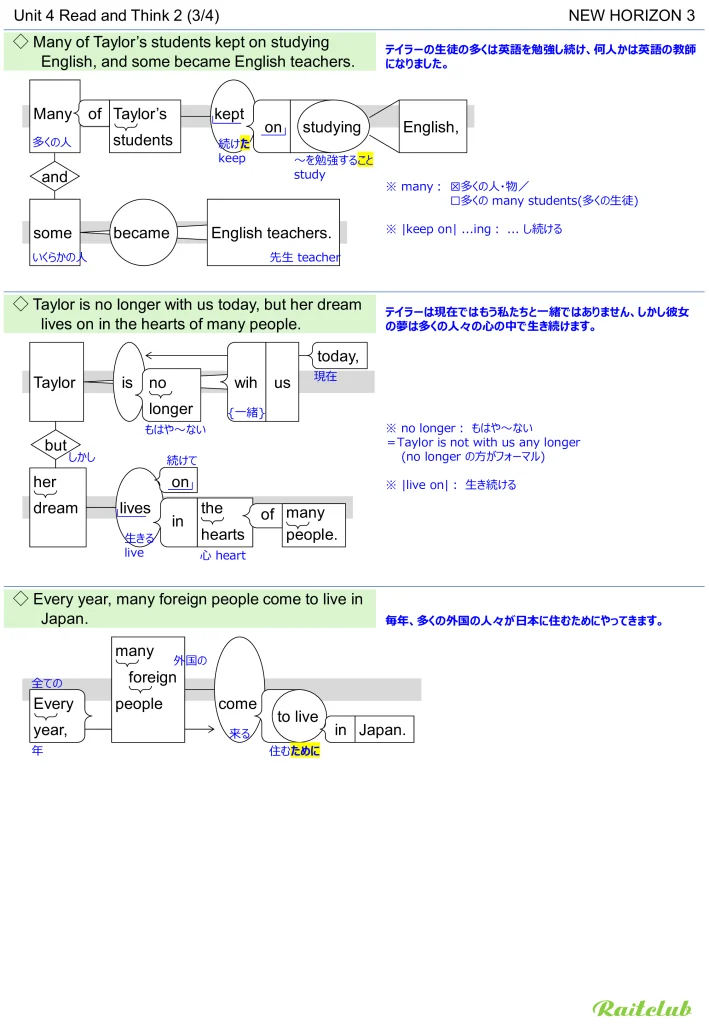
英文見える化チャート 4/4
